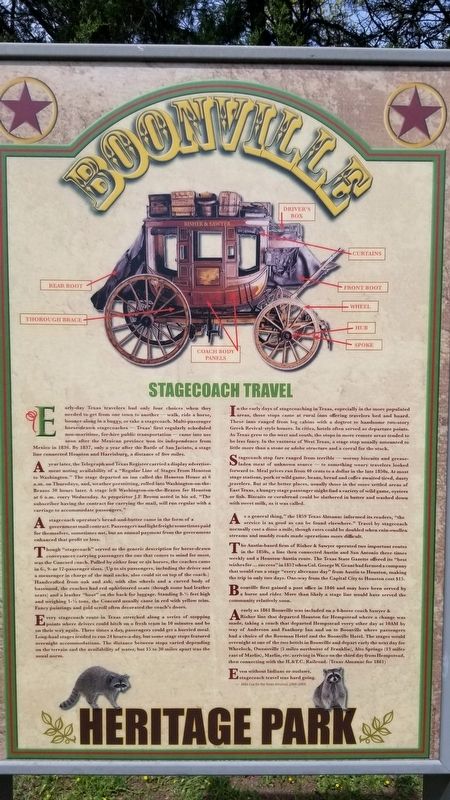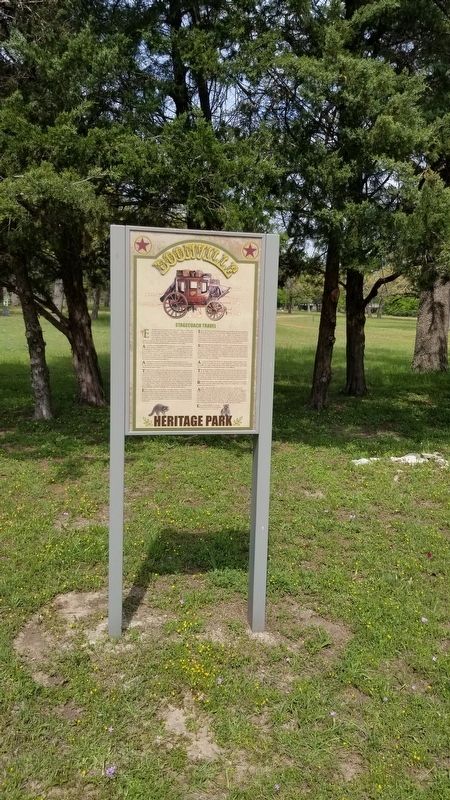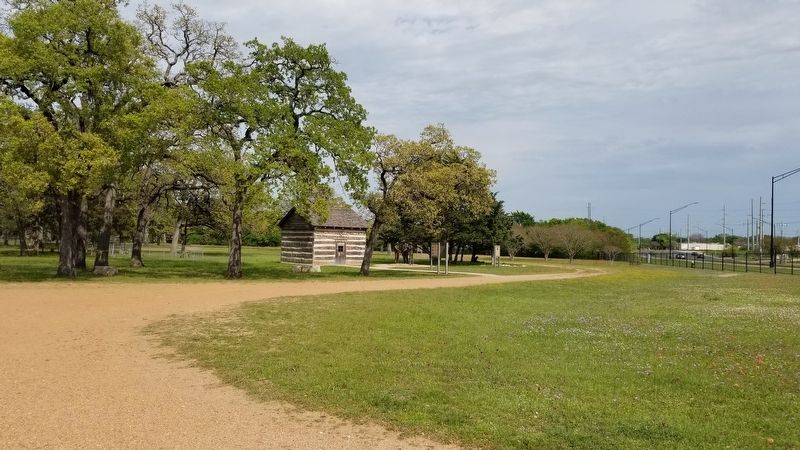Bryan in Brazos County, Texas — The American South (West South Central)
Stagecoach Travel
Boonville
Early-day Texas travelers had only four choices when they needed to get from one town to another — walk, ride a horse, bounce along in a buggy, or take a stagecoach. Multi-passenger horse-drawn stagecoaches - Texas' first regularly scheduled non-maritime, for-hire public transportation - came into use soon after the Mexican province won its independence from Mexico in 1836. By 1837, only a year after the Battle of San Jacinto, a stage line connected Houston and Harrisburg, a distance of five miles.
A year later, the Telegraph and Texas Register carried a display advertisement noting availability of a "Regular Line of Stages From Houston to Washington". The stage departed an inn called the Houston House at 6 a.m. on Thursdays, and, weather permitting, rolled into Washington-on-the Brazos 30 hours later. A stage left Washington-on-the-Brazos for Houston at 6 a.m. every Wednesday. As proprietor J.F. Brown noted in his ad, "The subscriber having the contract for carrying the mail, will run regular with a carriage to accommodate passengers."
A stagecoach operator's bread-and-butter came in the form of a government mail contract. Passengers and light freight sometimes paid for themselves, sometimes not, but an annual payment from the government enhanced that profit or loss.
Though "stagecoach" served as the generic description for horse-drawn conveyances carrying passengers the one that comes to mind for most, was the Concord coach. Pulled by either four or six horses, the coaches came in 6-, 9- or 12-passenger sizes. (Up to six passengers, including the driver and a messenger in charge of the mail sacks, also could sit on top of the coach.) Handcrafted from oak and ash, with elm wheels and a curved body of basswood, the coaches had red upholstered seats (though some had leather seats) and a leather "boot" on the back for luggage. Standing 8-1/2 feet high and weighing 1- 1/4 tons, the Concord usually came in red with yellow trim. Fancy paintings and gold scroll often decorated the coach's doors.
Every stagecoach route in Texas stretched along a series of stopping points where drivers could hitch on a fresh team in 10 minutes and be on their way again. Three times a day, passengers could get a hurried meal. Long-haul stages tended to run 24 hours-a-day, but some stage stops featured overnight accommodations. The distance between stops varied depending on the terrain and the availability of water, but 15 to 30 miles apart was the usual norm.
In the early days of stagecoaching in Texas, especially in the more populated areas, those stops came at rural inns offering travelers bed and board. These inns ranged from log cabins with a dogtrot to handsome two-story Greek Revival style houses. In cities, hotels often served as departure points. As Texas grew to the west and south, the stops in more remote areas tended to be less fancy. In the vastness of West Texas, a stage stop usually amounted to little more than a stone or adobe structure and a corral for the stock.
Stagecoach stop fare ranged from terrible — wormy biscuits and grease-laden meat of unknown source - to something weary travelers looked forward to. Meal prices ran from 40 cents to a dollar in the late 1850s. At most stage stations, pork or wild game, beans, bread and coffee awaited tired, dusty travelers. But at the better places, usually those in the more settled areas of East Texas, a hungry stage passenger might find a variety of wild game, oysters or fish. Biscuits or cornbread could be slathered in butter and washed down with sweet milk, as it was called.
As a general thing," the 1859 Texas Almanac informed its readers, "the service is as good as can be found elsewhere." Travel by stagecoach normally cost a dime a mile, though rates could be doubled when rain-swollen streams and muddy roads made operations more difficult.
The Austin-based firm of Risher & Sawyer operated two important route in the 1850s, a line then connected Austin and San Antonio three times weekly and a Houston-Austin route. The Texas State Gazette offered its
"best wishes for ... success" in 1852 when Col. George W. Granthad formed a company that would run a stage "every alternate day" from Austin to Houston, making the trip in only two days. One-way from the Capital City to Houston cost $15.
Boonville first gained a post office in 1846 and may have been served by a horse and rider. More than likely a stage line would have served the community relatively soon.
As early as 1861 Boonville was included on a 4-horse coach Sawyer & Risher line that departed Houston for Hempstead where a change was made, taking a coach that departed Hempstead every other day at 10AM by way of Anderson and Fanthorp Inn and on to Boonville where passengers had a choice of the Bowman Hotel and the Boonville Hotel. The stages would overnight at one of the two hotels in Boonville and depart early the next day for Wheelock, Owensville (5 miles northwest of Franklin), Alto Springs (13 miles east of Marlin), Marlin, etc. arriving in Waco on the third day from Hempstead, then connecting with the H.&T.C. Railroad. (Texas Almanac for 1861)
Even without Indians or outlaws, stagecoach travel was hard going.
- Mike Cox for the Texas Almanac 2008-2009
Erected by Boonville Heritage Park.
Topics. This historical marker is listed in this topic list: Roads & Vehicles. A significant historical year for this entry is 1836.
Location. 30° 40.322′ N, 96° 19.848′ W. Marker is in Bryan, Texas, in Brazos County. Marker can be reached from Boonville Road, 0.1 miles east of Austins Colony Parkway. The marker is located in the Boonville Heritage Park in the east section of the park. Touch for map. Marker is at or near this postal address: 2421 Boonville Road, Bryan TX 77802, United States of America. Touch for directions.
Other nearby markers. At least 8 other markers are within walking distance of this marker. Site of the Town of Boonville (here, next to this marker); Men of Vision (a few steps from this marker); Brazos County Courthouse (a few steps from this marker); The Old Boonville School Play Yard (within shouting distance of this marker); The Twin Sisters (within shouting distance of this marker); The Town Plat (within shouting distance of this marker); Turner-Peters Log Cabin (within shouting distance of this marker); Harvey Mitchell (within shouting distance of this marker). Touch for a list and map of all markers in Bryan.
Credits. This page was last revised on April 9, 2021. It was originally submitted on April 9, 2021, by James Hulse of Medina, Texas. This page has been viewed 351 times since then and 20 times this year. Photos: 1, 2, 3. submitted on April 9, 2021, by James Hulse of Medina, Texas.


